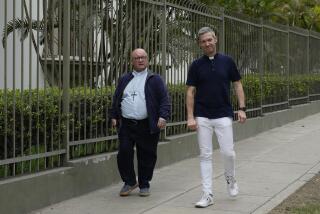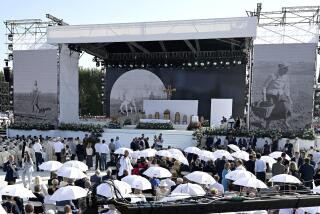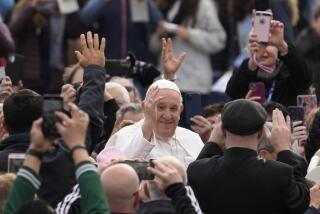2 Popes Beatified--1 Loved, 1 Loathed
VATICAN CITY — In a choice reflecting the complex spirit of his own reign, Pope John Paul II on Sunday beatified an odd couple of predecessors--the autocratic, reactionary 19th century Pope Pius IX and the modernizing 20th century Pope John XXIII.
A solemn liturgy before 100,000 sun-drenched worshipers in St. Peter’s Square brought the two Italian pontiffs, who presided over opposing shifts in Roman Catholic Church history, to within a step of possible sainthood.
By honoring the openly anti-Semitic Pius IX, John Paul sparked an outcry from Jews--a people both he and John XXIII labored to embrace and reconcile with Catholics. Jewish protests in advance of the ceremony made it one of the most contested of John Paul’s 22-year-old papacy, which has created 1,255 saints and “blessed” would-be saints as role models for Catholics.
The uproar paled, however, before a gush of affection Sunday for the jovial, self-effacing John XXIII, the favorite of a crowd that applauded him as “il papa buono”--the good pope. Many worshipers said they knew little or nothing about Pius IX, even though his rule, from 1846 to 1878, remains the longest of any pontiff since St. Peter founded the church.
For those who know papal history, the contrast couldn’t be more striking.
The son of an Italian count, imperious Pius clung tenaciously to the centuries-old Papal States until Italian nationalist armies abolished the church’s temporal kingdom in 1870. But he strengthened the papacy itself, proclaiming papal infallibility. His “Syllabus of Errors” castigated modern thinking, dividing the world between Catholic faithful and diabolical enemies.
Jews today remember that he confined their Roman ancestors to a walled ghetto, stripped them of property and called them “dogs.” He scandalized Europe by adopting a 6-year-old boy whom papal guards had abducted from Italian Jewish parents and raising him to be a priest.
The peasant-born John XXIII, who reigned from 1958 to 1963, was an accessible champion of human rights and religious tolerance. He revived the custom, abolished by Pius IX, of papal visits to the sick, the imprisoned, the needy and other faithful of Rome, who welcomed him as a benevolent, roly-poly grandfather.
By convening the Second Vatican Council in 1962, he set in motion a sweeping liberalization that undid much of Pius IX’s legacy: It permitted Mass in local languages, gave local bishops more authority and promoted interfaith dialogue.
John Paul’s papacy, which has re-centralized Vatican authority and forged a humanist, ecumenical mission of global reach, builds on the legacy of both predecessors. In a homily Sunday, he praised them in equal measure.
In a 19th century Europe swept by revolution, he said, Pius IX set “an example of unconditional adherence to the unchanging depository of revealed truth,” giving “absolute primacy to God and spiritual values.”
Without mentioning the Jewish boy’s abduction or any other specific criticism, John Paul acknowledged that Pius was “much loved, but also hated and slandered.” However, it was Pius’ sanctity, he said, that mattered.
“Sanctity lives in history, and every saint is not removed from the limitations and personal conditioning of our human nature,” the pope said.
“By beatifying one of its sons,” he added, “the church does not celebrate particular historical choices he made, but rather points to him for imitation and veneration for his virtues, praising the divine grace that shines in him.”
The crowd at St. Peter’s applauded politely while listening to Pius IX’s attributes, then erupted like a thunderclap when the pope recalled John XXIII’s “prophetic intuition” to summon the Vatican Council and thus open “a season of hope for Christians and for humanity.”
“Pope John remains in the memory of all as the image of a smiling face and two arms opened wide to embrace the entire world,” he added.
“John was a pope for our time,” said Patrizia Longo, 50, an Alitalia airline engineer. “He showed the way for the other modern popes.”
Other middle-aged worshipers said John XXIII’s death from cancer in June 1963 was as stunning as the assassination of President Kennedy later that year, because both leaders had raised hopes and perished too early to fulfill them.
In religious shops near St. Peter’s, pilgrims snapped up photos and prayer cards of John XXIII. Pius IX prayer cards weren’t stocked, merchants said, because no one ever asks for one. Pius’ cheering section at the two-hour liturgy consisted of 1,800 people from his hometown, Senigallia, and a few hundred descendants of Catholic nobility.
Church officials took pains to deny the obvious: that Pius IX was honored at the behest of powerful Vatican conservatives to dilute John XXIII’s limelight.
John Paul insisted Sunday that the shared ceremony was a result of “divine design.” He noted that John XXIII had once called for Pius IX’s beatification out of a “deep veneration” for his predecessor.
Three others were beatified in Sunday’s ceremony: Tommaso Reggio, a 19th century Italian bishop who founded the Congregation of the Sisters of St. Martha; Guillaume-Joseph Chaminade, a French priest who founded the Marianist Family in 1800; and Joseph-Aloysius, an Irish monk who, as Columba Marmion, served as abbot of the Benedictine Maredsous Abbey in Belgium in the early 1900s.
More to Read
Sign up for Essential California
The most important California stories and recommendations in your inbox every morning.
You may occasionally receive promotional content from the Los Angeles Times.









